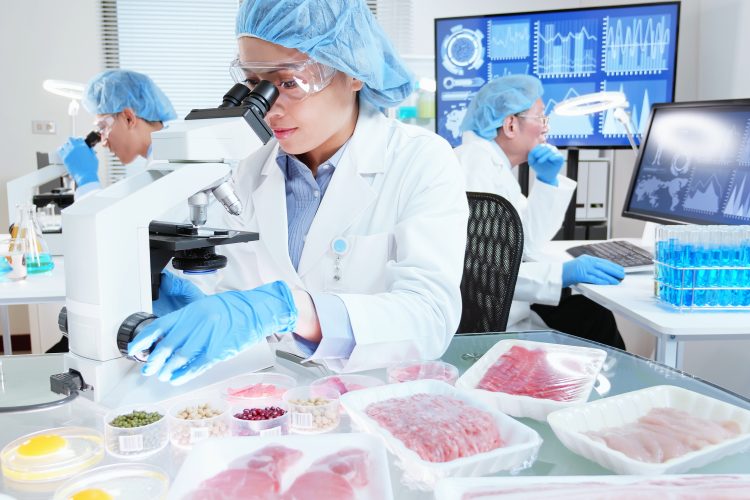AI’s potential to enhance food safety practices
- Like
- Digg
- Del
- Tumblr
- VKontakte
- Buffer
- Love This
- Odnoklassniki
- Meneame
- Blogger
- Amazon
- Yahoo Mail
- Gmail
- AOL
- Newsvine
- HackerNews
- Evernote
- MySpace
- Mail.ru
- Viadeo
- Line
- Comments
- Yummly
- SMS
- Viber
- Telegram
- Subscribe
- Skype
- Facebook Messenger
- Kakao
- LiveJournal
- Yammer
- Edgar
- Fintel
- Mix
- Instapaper
- Copy Link
Posted: 11 April 2024 | John Simpson | No comments yet
In this article, AI’s potential in bolstering food safety is explored, including how it can be used to help detect contamination before it becomes a foodborne illness.


The journey towards integrating Artificial Intelligence (AI) into food safety practices marks a pivotal evolution in how the food industry manages hygiene and safety protocols. Historically, data on food safety is vast but very fragmented.
It is often collected through traditional methods that create a lag in providing real-time insights that are necessary for proactive decision-making. However, with the steady implementation of digital transformation programmes across the food production sector, the landscape is shifting. With the increasing adoption of innovative hygiene inspection solutions that incorporate immediate data capture at the point of testing, we are starting to see a tangible pathway to access real time analytics to transform food safety culture from reactive to proactive.
In this article, we will explore how technology, and the current trend of AI and machine learning, has the ability to redefine cleanliness standards across food production and retail sectors.
Tapping into traditional limitations
Traditional hygiene testing practices in the food industry, such as microbiological culturing, ATP testing, and chemical indicators, do not typically give immediate results and require specialised equipment or training.
In the scenario of a typical food contamination event, where a batch of products is found to be contaminated with Salmonella, the discovery triggers a cascade of reactive steps. This can include a public recall of the affected products, extensive media announcements to warn consumers, and a costly shutdown of production lines for deep cleaning and investigation. This approach not only incurs significant financial loss but can also damage a brand’s reputation and impact consumer trust.
Navigating new horizons
By embracing AI and machine learning to make sense of extensive data sets in food safety, we can now trace contamination sources, predict hygiene failures, and even anticipate disruptions within the supply chain.
Yet, as we navigate this promising horizon, we encounter the critical need to balance innovation with data sensitivity. To bring stakeholders to the table robust encryption, stringent data access controls, and continuous security monitoring are critical to future success.
Connected data is an important step to predictive analytics and our industry must remain unwavering in our commitment to data privacy, regulation compliance, and the ethical use of technology.
Anonymous predictive power
Much like the advancements seen in healthcare where AI has been instrumental in advancing treatments and predicting outbreaks, the transformative potential in food safety is underscored by its ability to leverage anonymized data for predictive analytics.
By applying similar principles, AI models in the food industry have the ability to forecast potential contamination and food safety breaches, enabling businesses to shift from a reactive to a proactive stance. By bringing together and analysing comprehensive data sets within one system, AI can detect sporadic contamination patterns and identify contamination harbourage points such as machine seals.
Going further, this predictive insight can then be anonymously shared with the food industry to mitigate the same issue occurring for other businesses. These insights can further be refined by correlating with seasonal changes or shift times as more data is analysed, enabling predictions of specific bacterial presence, such as Listeria monocytogenes in winter or Salmonella in summer.
As AI continues to evolve, its role in enhancing traceability and transparency becomes increasingly critical, offering the ability to quickly trace back sources of contamination, thereby not only safeguarding public health but also protecting brand reputation.
Optimising supply chains
The application of AI can also extend beyond prediction by playing a crucial role in optimising the supply chain for enhanced efficiency and safety. Through real-time monitoring and risk assessment, AI technologies offer a panoramic view of the supply chain, identifying bottlenecks and potential contamination sources before they become issues.
This level of traceability and transparency was previously unattainable, marking a significant leap towards ensuring the integrity of food from farm to table. Such advancements not only facilitate quicker responses to contamination events but also contribute to a more sustainable and ethical food production system, reflecting a growing consumer demand for transparency.
Addressing the challenges
Despite the promising prospects of AI in food safety, there are challenges to its implementation, ranging from data privacy concerns to the need for a robust technological infrastructure. Ethical considerations also loom large, especially regarding how data is collected, shared, and used.
However, by adopting stringent data privacy standards and focusing on the development of ethical AI, the food industry can navigate these challenges. The establishment of a legal framework and shared platforms for data exchange, as seen in initiatives by the European Food Safety Authority (EFSA), points towards a collaborative approach in overcoming these obstacles.
Further industry research completed by the European Parliamentary Research Service suggests building a robust infrastructure that supports AI integration can be key to unlocking its full potential, paving the way for a future where food safety and quality are significantly enhanced through technology.
Workforce and regulation
The successful implementation of AI in food safety will require the industry to communicate and educate the workforce on the approaches and methods involved in utilising AI data, and acting on its recommendations.
To allow the use of AI to expand effectively into the food industry, companies will need to communicate to their staff how to use new AI tools to enhance their day-to-day practises, rather than be seen as a nuisance. AI tools can help to empower staff at every level of a company, with managers being able to rapidly report and monitor sites, as well as sample collectors having the ability to rapidly act on any issues observed from their testing. Behavioural change is challenging, so there is a pressing need to hire professionals with expertise in data analytics, AI programming and system integration who can ensure that new data systems are implemented in a well communicated fashion, and meets all regulatory requirements.
Opting for a phased approach
Recognising the meticulous nature of the food industry, we believe a measured exploration of the potential benefits of AI can provide a clear route to adoption. A phased approach can enable enterprises to understand the benefits of AI while managing brand and reputational concerns.
Central to this journey is addressing data privacy considerations through solid security measures and ethical data practices, ensuring that the adoption of AI enhances consumer trust rather than undermining it. Additionally, cultivating a skilled workforce adept in AI and data analytics, coupled with navigating regulatory landscapes, will be pivotal in overcoming implementation barriers.
The pathway to adoption
Looking ahead, we envision a food industry that not only embraces AI for its operational benefits but also sees it as a catalyst for building a more transparent, safe, and efficient food supply chain. This future is not just about leveraging technology for the sake of innovation but about fostering a human culture of safety and quality that benefits all stakeholders through producers, consumers, and regulators alike. By approaching AI adoption with an open mind and a commitment to collaboration and continuous improvement, we can pave the way for a food industry that is not only more resilient to safety challenges but also more responsive to the evolving demands of a global consumer base.
The more heterogeneous data that can be incorporated into AI models, from a range of sources including all sizes and types of food producers, restaurants and commercial kitchens through to regulators, the sharper an AI model can be in informing the entire food industry in predicting food safety trends and providing the most efficient routes to proactive food safety.
Empowering safety
New technology often fails to roll out when it is poorly understood by the user. AI must be seen and demonstrated to enhance a manager’s work process, empowering a safety auditor in their reporting and aiding a cleaner in proactively responding to a detected risk. When setting out on our mission to make contamination visible through a simple colour change technology test, making hygiene accessible to all levels of the food sector has been a central tenet of our vision. By working with industry partners combining simple and quick hygiene testing with cloud data solutions we firmly believe that AI can be used as a powerful tool to ensure the highest standards of food safety and quality, today and in the years to come.
To find out more about the impact of AI in the food sector, listen to New Food’s two part podcast series on the applications of AI here.
About the author











